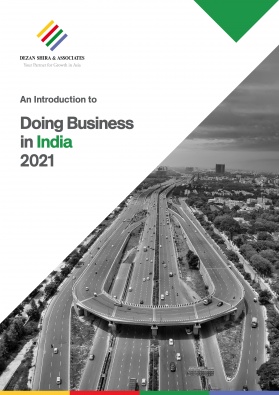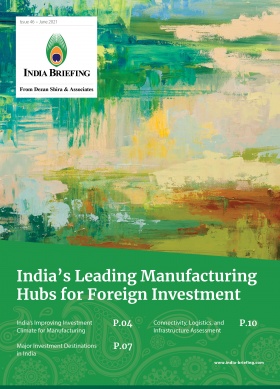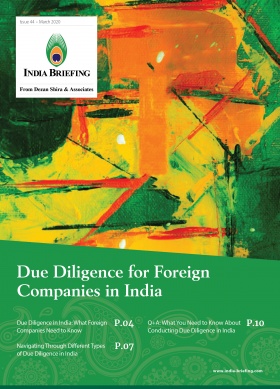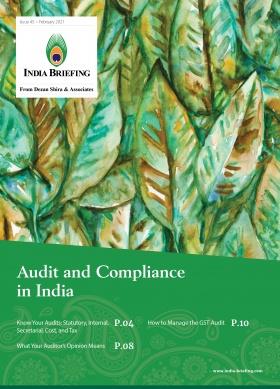What is the National Monetisation Pipeline? India’s Funding Plan for the Infrastructure Sector
We provide a breakdown of the Indian federal government’s ambitious National Monetisation Pipeline, which will be implemented over the next four years. The government aims to attract investments to the tune of INR 6000 billion (US$81 billion) by monetising its core assets in the 13 strategic sectors through this pipeline, including railways, roadways, power generation, etc. The scheme leases the assets to private players on a long-term basis, with substantial rights, opening up new opportunities for foreign investors in the infrastructure sector.
On August 23, 2021, India launched the asset monetisation pipeline of federal ministries and public sector entities – ‘National Monetisation Pipeline (NMP: Volume I and Volume II)’. This scheme aims to monetise core assets under the Central Government to the tune of INR 6000 billion (US$81 billion) over a period of four years, from FY2022 to 2025, coterminous with the National Infrastructure Pipeline.
The pipeline is envisaged as a holistic approach, which not only serves as an infrastructure funding mechanism but is aimed at bringing an overall “paradigm shift in infrastructure operations, augmentation and maintenance”, by leveraging resource efficiencies of the private sector and adapting to global best practices.
The NMP’s two volume roadmap has been formulated by the government’s policy think tank Niti Aayog, in consultations with infrastructure line ministries to fulfill the asset monetisation mandate of the government as proposed in the Federal Budget 2021-22.
The government has clarified that while the rights will be transferred to private players, the ownership will be retained by the government.
What does the National Monetisation Pipeline propose?
The NMP is a new scheme to establish structured contractual partnerships between the government and private players and thereby generate sustainable infrastructural funding by monetising core brownfield infrastructural assets, that is, assets where operational infrastructure has already been built.
The scheme will enable infrastructure creation through mutually beneficial collaboration between the public and private sectors, each of whom excel in their respective areas of competence, and deliver on the government’s socio-economic growth promises. The NMP does not include monetisation proposals through disinvestment or through programs linked to non-core assets.
For the purpose of monetisation, core assets refer to those assets that are central to the business objectives of a public entity or a statutory/government body and are being utilized for delivering infrastructure services to the public and users at large.
The NMP roadmap identifies 13 core sectors under which assets are to be monetised (see below section). These identified assets will be leased out to the private sector on a long-term basis. It is being reported that the lease will be applicable for four to five decades.
The NMP has laid down the conceptual approaches and potential models for asset monetisation, including the Public Private Partnership (PPP) model.
While the pipeline currently includes only assets under Central Government line ministries and Central Public Sector Enterprises (CPSEs) in infrastructure sectors, the process to coordinate the asset pipeline of respective Indian states is simultaneously ongoing.
How will the National Monetisation Pipeline be implemented?
The assets and transactions will be backed by various direct contractual and capital market instruments, subject to parameters like sector, nature of asset, timing of transactions etc. Suitable policy and regulatory interventions will be made on an as-needed basis. Work is underway to set up an asset monetisation dashboard for real-time monitoring.
An empowered committee has been constituted by the government to implement and monitor the program – the Core Group of Secretaries on Asset Monetisation (CGAM) will be headed by the Cabinet Secretary.
How is the valuation of these assets derived under NMP?
For each of these sectors, the NMP has been drawn for potential assets to be put up for monetisation based on three key sets of information:
- Potential asset value
- Asset considered for monetisation
- Indicative monetisation value
The indicative monetisation value can be estimated by following various approaches, such as:
- Market Approach: Under this approach, the indicative value is determined based on the comparable market transactions for the identified asset classes.
- Capex Approach: This approach is considered for those asset classes that may be monetised through PPP-based models expecting capital expenditure investment by the private sector. In such cases, substantial capital expenditure towards augmentation of infrastructure delivery is expected over the transaction life. The principle under the capex approach is that in the absence of the asset monetisation transaction, the public asset owner (government) would have to incur the outlay towards augmentation of the brownfield asset.
- Book Value (BV) Approach: This approach is employed in case of asset classes where information on comparable market transactions or estimated capex investment is not available.
- Enterprise Value (EV) Approach: This approach is considered for assets where information on the existing revenue stream is available or can be reasonably projected, either on the basis of assumptions or the available data on prevailing tariff for an asset or asset class.
Sector-wise breakdown of the asset monetisation program
Roads, railways, and power sector assets will comprise over 66 percent of the total indicative value of the potential assets to be monetised, and sectors like telecom, aviation etc. will comprise the remaining share.
Here is a sector-wise breakdown of the National Monetisation Pipeline.
Roads
Road assets aggregating to 26,700 kms, comprising 22 percent of National Highways (NHs) will be considered for monetisation over the next four years. The indicative monetisation value will be estimated using the market approach. The government is expecting to invite INR 1600 billion (US$21.55 billion) by monetising these road assets through potential models like Toll Operate Transfer (ToT) and Infrastructure Investment Trust (InvIT).
The InvIT, which will be issued by the National Highway Authority of India (NHAI), will be privately placed and indicative monetisation value of the fund raised from the current tranche underway is about INR 50 billion (US$678 million). Individuals will be also able to participate in asset class investing through new models, such as InvIT and Real Estate Investment Trusts.
Railways
The railway sector will monetise assets having an indicative value of INR 1525 billion (US$20.70 billion) over the next four years. The key rail assets identified for monetisation include 400 railway stations, 90 passenger trains, one route of 1400 km railway track, 741 km of Konkan railway, 15 railway stadiums and selected railway colonies, 265 railway owned goods-sheds and four hill railways. While this indicative monetisation value will be estimated based on the Capex Approach for railway stations, passenger trains, railway colonies and private freight terminals, the Book Value Approach will be adopted for estimating the monetised value of track infrastructure.
Power transmission
The government intends to invite investments worth INR 452 billion (US$6.12 billion) by monetising assets under this sector and the Market Approach will be employed while estimating the indicative monetised value of these assets. The transmission assets that will be considered for monetising over the next four years aggregate to 28,608 circuit km, including transmission assets of 400 kilovolt (KV) and above of the Power Grid Corporation of India Limited (PGCIL).
Among the asset base of PGCIL, monetisation opportunities are available in the category of long-distance transmission assets, which comprise an assortment of Tariff Based Competitive Bidding (TBCB) and Regulated Tariff Mechanism (RTM) assets. Factors like transmission charges, asset availability, and asset mix will determine the assets that will be considered for monetisation. The indicative monetisation value of the transmission assets has been considered based on a factor of INR 15.8 million (US$0.21 million) per circuit km.
Power generation
An asset base of six gigawatt (GW), fetching a value of INR 398 billion (US$5.40 billion), will be considered for monetisation under NMP. This valuation has been done using the Book Value Approach. Key entities whose assets have been considered are National Hydroelectric Power Corporation (NHPC), National Thermal Power Corporation Limited (NTPC) and the Satluj Jal Vidyut Nigam Limited (SJVNL) who own bulk of the hydel assets, and NTPC and Neyveli Lignite Corporation Ltd (NLC) that own renewable assets.
These assets constitute seven percent share in terms of the total value expected to be raised under NMP.
Natural gas pipelines
The assets considered for monetisation are select gas pipelines with an aggregate length of 8,154 km, of which 7,928 km are from the existing operational pipeline assets and the rest are from pipelines that are expected to become operational during the NMP period, that is, FY22-FY25. These assets are expected to fetch a value of INR 244.62 billion (US$3.31 billion) based on the Enterprise Value Approach.
Out of the total assets identified in this sector, two pipelines with a total length of 2,229 km namely, Dabhol-Bengaluru pipeline and Dahej-Uran-Panvel-Dabhol pipeline, will be monetised during FY22.
The total assets considered for monetisation over the four-year period form around 23 percent of the aggregate pipeline asset base in India. For this sector, the Carry-Operate-Transfer (COT) concession model has been envisaged as a suitable model under the pipeline.
Petroleum, petroleum product pipelines, and other assets
Under NMP, monetisation of assets under this category is expected to raise funds worth INR 225 billion (US$3 billion), based on the Enterprise Value Approach.
The asset classes identified for monetisation under this sector include 733 km LPG pipelines, 3196 km petroleum product pipelines, two hydrogen generation plants, and ESG assets (effluent treatment plants, sulphur recovery units, flare gas recovery systems).
Urban real estate
Under the NMP, the government intends to monetise real estate to the tune of INR 150 billion (US$2 billion). The value estimation has been done using Capex Approach.
Under urban real estate assets, the government has called for the development of housing or commercial units on 240-acre land in Ghitorni in the national capital, Delhi. The government has also recognized redevelopment of seven General Pool Residential Accommodation (GPRA) Colonies in Delhi, under the same category of assets. These seven colonies are located in Sarojini Nagar, Naoroji Nagar, Netaji Nagar, Sriniwaspuri, Thyagraj Nagar, Mohammadpur, and Kasturba Nagar.
Under the hospitality category, the eight hotels of India Tourism Development Corporation (ITDC) will also be monetised through different routes like long-term leasing, divestment, long-term OMT (operate, maintain, and transfer) contract etc., which shall be ascertained on a case-to-case basis.
The eight hotels are Hotel Pondicherry, Puducherry; Hotel Kalinga, Bhubaneshwar; Hotel Ranchi, Ranchi; Hotel Nilachal, Puri; Hotel Anandpur Sahib, Rupnagar; Hotel Samrat, New Delhi; Hotel Ashok, New Delhi; and Hotel Jammu Ashok, Jammu.
Telecom
Monetisation of telecom assets is expected to garner an indicative amount of INR 351 billion (US$4.8 billion). The indicative valuation is based on Capex Approach for Bharatnet fibre assets and Market Approach for tower assets.
The NMP roadmap for telecom sector has envisaged over 286 thousand km of optical fibre assets laid by BBNL and BSNL under rural broadband project Bharatnet for monetisation at a value of INR 263 billion. The NMP has also considered 13,567 mobile tower assets of BSNL and 1,350 of MTNL for monetisation over the four-year period. The telecom sector is expected to deliver six percent of the total monetisation value that the government intends to realize by FY25.
Warehousing
The government aims to monetise warehousing assets owned by state-owned firms, Food Corporation of India (FCI) and Central Warehousing Corporation (CWC), for an indicative value of INR 289 billion (US$4 billion) and the Capex Approach has been adopted for this valuation.
The aggregate storage capacity with FCI and CWC is estimated to be around 52.1 million tons (41.2 million tons with FCI and 10.9 million tons with CWC). Out of this, storage infrastructure of 12.3 million tons of FCI and 11 million tons of CWC is amenable for monetisation as these facilities have a strong potential for augmentation and capacity expansion.
For monetising these warehousing assets, PPP models similar to the TOT model adopted by NHAI for highways and OMD-based model are considered suitable.
Mining
The indicative monetisation value of coal mining assets based on the Capex Approach is INR 287.5 billion (US$3.9 billion) for duration of the policy, that is, four years. For this purpose, 160 coal mining assets have been identified, which include 17 projects based on the Mine Developer and Operator (MDO) model, establishment of three washeries based on the Build, Own, Operate (BOO) model, 35 identified first-mile connectivity projects for building coal silos/ mechanized loading, one coal gasification plant and commercial auction of coal mines.
About 761 mineral blocks are expected to be put on auction during FY2022-FY25. In FY22, auction of 138 mineral block assets will take place, followed by 253 mineral block assets in 2022-23, 210 in 2023-24 and 160 in 2024-25.
Aviation
The government is expecting to monetise 25 Airport Authority of India (AAI) managed airports, including Varanasi, Udaipur, Dehradun, Indore, Ranchi, Coimbatore, Jodhpur, Vadodara, Patna, Vijayawada, Chennai, Nagpur, and Bhubaneshwar by FY25. This monetisation drive is estimated to garner funds worth INR 207.8 billion (US$2.8 billion), based on the Capex Approach.
The NMP has also considered AAI’s residual stakes in four joint ventures for monetisation, which include private sector operated airports in Mumbai (26 percent stake), Delhi (26 percent stake), Hyderabad (13 percent stake), and Bangalore (13 percent stake).
Shipping
A total number of 31 shipping assets worth INR 128 billion (US$1.8 billion) will be monetised between FY22 and FY25. The Capex Approach has been employed while estimating this monetised value. PPP model will likely be employed in this sector, and it will be implemented by the Ministry of Ports, Shipping, and Waterways.
The 31 assets, which will likely be monetised, are spread over nine among the 12 major ports. These identified assets will further be augmented for improved operational efficiency and capacity utilization through key projects like additional berths, mechanization, development of oil jetty, container jetties, Operations and Maintenance (O&M) of container terminal, O&M of International cruise terminal, and development of marina.
Stadiums
The government aims to monetise two national stadiums, including the Jawaharlal Nehru stadium and two regional centers to the tune of INR 114.5 billion (US$1.6 billion), with valuation based on the Capex Approach.
These potential assets are held by the Sports Authority of India (SAI). The model of monetisation will be PPP-based concessions on Operations, Management, and Development Agreement (OMDA) model.
The move is expected to facilitate the provision of world class sports infrastructure as the private sector is expected to introduce an integrated multi-use sports infrastructure development model, focusing on the optimization of sports facilities and upgrading sports infrastructure technology.
What are the concerns raised by the stakeholders?
The anticipated transfer of assets, possibly into the hands of state cronies, has been a criticism of the government’s plans, especially since these have national strategic value. It is argued that in the long-term, the status of these projects will impact the interest of common citizens as there is currently no clarity on checks and price caps that the government will impose on these private players.
Concerns have also been raised with respect to the valuation models and lack of identifiable revenue streams in various assets has been considered a challenge to attract diverse participation, inevitably raising the specter of vested interests and corruption. Additionally, no dispute resolution mechanism has been specified in the roadmap laid out by the government.
About Us
India Briefing is produced by Dezan Shira & Associates. The firm assists foreign investors throughout Asia from offices across the world, including in Delhi and Mumbai. Readers may write to india@dezshira.com for more support on doing business in in India.
We also maintain offices or have alliance partners assisting foreign investors in Indonesia, Singapore, Vietnam, Philippines, Malaysia, Thailand, Italy, Germany, and the United States, in addition to practices in Bangladesh and Russia.
- Previous Article Debt Funding in India: Options Available to Foreign Investors, Entrepreneurs
- Next Article Major Investment Destinations in India









